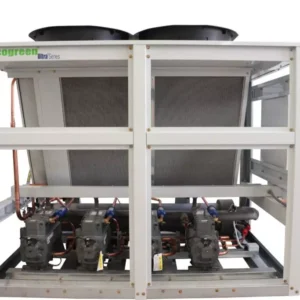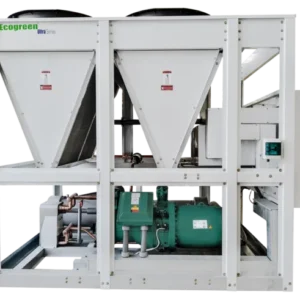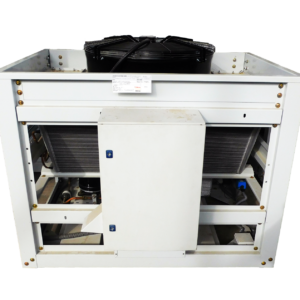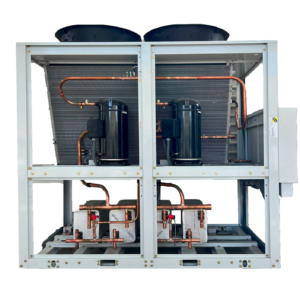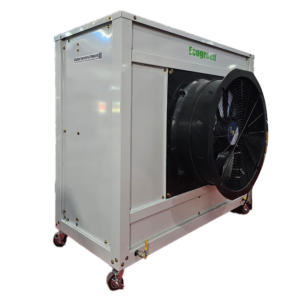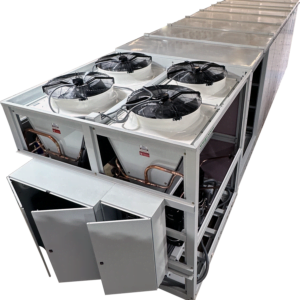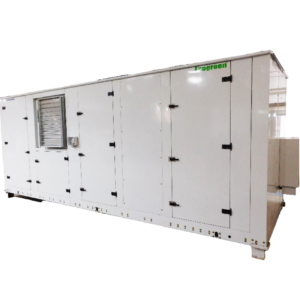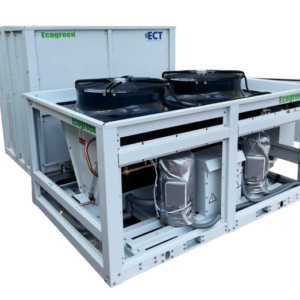A2L REFRIGERANT CONSIDERATIONS
A2L refrigerants have been on the radar of the commercial refrigeration industry as promising alternatives to high global warming potential (GWP) hydrofluorocarbon refrigerants (HFCs). With a GWP below 300 and in some cases even below 150, some A2L refrigerants offer a more environmentally sustainable option.
However, due to their chemical composition, which includes components with high hydrofluoroolefin (HFO) content, A2Ls can have different levels of flammability. For this reason, they are assigned the classification of "slightly flammable" or A2L.
In the United States, the adoption of A2L refrigerants in commercial refrigeration is in its initial stages. Regulatory approval processes and additional updates to safety standards and building codes are being carried out to facilitate widespread adoption in the industry. A recent update to the Underwriters Laboratories (UL) Standards for Safety - UL 60335-2-89 - has been a key step in this approval process. Many industry experts see this update as a significant development that could accelerate the adoption of A2L refrigerants in the coming years.
A2L refrigerants offer a unique solution within the refrigerant landscape, as they exceed the approved charge limits for R-290 and represent a higher capacity alternative in self-contained applications. In addition, they can be applied in distributed architectures, such as remote outdoor condensing units or mini-racks used in smaller format stores. Regardless of the most common applications, A2Ls provide new options for companies to meet regulatory compliance and operational sustainability goals.
For stakeholders in the commercial refrigeration industry, this means that when planning the transition of refrigerants in the long term, cooling strategies with A2L are a viable option to be considered. Original equipment manufacturers (OEMs) should begin designing equipment with A2L in mind to prepare for the next wave of adoption. Contractors, consultants and owner/operators should also educate themselves about A2Ls in anticipation of their widespread adoption.
In terms of regulations, additional regulatory steps will be required to facilitate the adoption of A2L refrigerants. It is important that these regulations address specific safety and maintenance aspects to ensure a safe and efficient implementation of A2L in the commercial refrigeration industry.
In summary, the transition to A2L refrigerants represents an exciting opportunity for the commercial refrigeration industry, offering new options to comply with regulations and improve operational sustainability. However, it is crucial that all stakeholders are adequately prepared and understand the challenges and considerations associated with the use of A2L in their operations.
THE ROUTE TO A2L REFRIGERANT APPROVAL
Changes in safety standards and building codes are essential to ensure the safe use of A2L and A3 refrigerants in commercial refrigeration equipment. These updates reflect the need to adapt regulations to new technologies and products in the industry.
The second edition of UL 60335-2-89, approved by UL, provides specific guidelines on A2L loading limits for remote and self-contained refrigeration systems. These load limits are based on considerations such as equipment design (open or enclosed with doors) and take into account different A2L mixtures, which vary in their level of flammability.
It is important to note that the amount of refrigerant charge in the system (represented by the variable "m") must be carefully controlled and monitored to mitigate the risks associated with flammability. The variable "m1" represents the maximum allowable charge in a self-contained system, which can be factory charged without the need for leak detectors or other mitigation measures, such as venting.
These guidelines and charge limits are essential to ensure that commercial refrigeration equipment using A2L refrigerants are designed, installed and operated safely. They also provide manufacturers, contractors and owner/operators with a clear framework for complying with regulations and safeguarding public health and safety.
The "LFL" (Lower Flammability Limit) is an important measurement that indicates the volume percent present in air, at normal temperature and pressure, that can initiate ignition. Below the LFL, the vapor/air mixture will not ignite.
For self-contained equipment, it can be designed to operate properly with less than the "m1" refrigerant charge, which is the maximum allowable charge without the need for leak detectors or special mitigation measures. For example, R-454C refrigerant, with an LFL of 0.291 kg/m3, can be used in a display case closed by doors with a charge of up to 2.33 kg (5.1 lb.). For an open display case, the charge can be up to 3.78 kg (8.3 lb.).
As long as the self-contained equipment is below the "m1" charge, no leak detection or special mitigation measures are required. However, equipment with a flammable refrigerant charge above 150 g must pass leak testing as specified in Annex CC.
These considerations are crucial to ensure safety in the design and operation of commercial refrigeration equipment using A2L and A3 refrigerants, and to comply with relevant regulations and safety standards.
Learn more about our Chillers
ENABLE HIGHER LOADS ON REMOTE SYSTEMS
UL 60335-2-89 allows the use of some A2L refrigerants in remote or field-built systems with charges up to 75.7 kg (166 lb.). However, the use of larger charges of A2L refrigerants in remote systems requires additional safety measures to mitigate the risks associated with the flammability of these refrigerants.
It is important to note that specific charge calculations will be based on the LFL (Lower Flammability Limit) of the specific A2L refrigerant and the particular type of application. This involves considering factors such as system design, equipment location and available risk mitigation measures.
For larger charges of A2L refrigerants in remote systems, additional safety measures may be necessary, such as the installation of more sophisticated leak detection systems, improved ventilation systems, and more robust emergency response protocols. In addition, it is critical that personnel are properly trained in the safe handling of these refrigerants and in the implementation of appropriate safety measures.
In summary, while UL 60335-2-89 allows the use of higher A2L refrigerant charges in remote systems, it is crucial to implement additional safety measures to ensure safe operation and comply with relevant regulations. This requires careful assessment of the risks and implementation of appropriate measures to mitigate them.
ADDITIONAL APPROVALS REQUIRED
The UL 60335-2-89 update marks a fundamental step in the process of enabling the use of A2L refrigerants in commercial refrigeration in the United States. However, several additional updates in regulations and safety standards will still be required to complete this process:
Approval of Specific A2L Refrigerants: The Environmental Protection Agency (EPA) must approve specific A2L refrigerants as acceptable alternatives within its Significant New Alternatives Policy (SNAP). This approval is essential to ensure that the refrigerants used meet environmental and safety requirements.
2. Model Code Updates: Model codes, such as the International Mechanical Maintenance Code (IMC) and the International Energy Code (IEC), should be updated to include specific provisions related to the safe use of A2L refrigerants in commercial refrigeration equipment. These updates will provide clear guidelines for designers, manufacturers and end users.
3. State and Local Building Code Updates: State and local building codes should also be reviewed and updated to reflect safety provisions related to the use of A2L refrigerants. This will ensure consistency in regulations across the country and provide a clear framework for the safe installation and operation of commercial refrigeration equipment.
Together, these regulatory and standards updates are crucial to establish a clear and consistent regulatory environment that allows the safe and effective adoption of A2L refrigerants in commercial refrigeration in the United States. This will benefit both the environment and the safety and efficiency of refrigeration systems.
The anticipation of the update of the ASHRAE 15 standard and EPA SNAP approvals in 2022 for some A2L refrigerants marks an important milestone on the road to widespread adoption of these refrigerants in the commercial refrigeration industry in the United States. The upcoming Model Code update in 2024 is also expected to contribute to this process, although some states have already legislated automatic building codes, which could accelerate the adoption of A2Ls.
It is expected that some A2L refrigerants will be approved for use from 2023, with more widespread adoption in 2024. However, the installation of an A2L-based refrigeration strategy will require the approval of the relevant local authorities, such as fire chiefs and building inspectors.
The passage of the AIM Act in 2020 provided an additional basis for A2L use by giving EPA the authority to regulate HFCs and promote the transition to lower global warming potential refrigerants. In addition, EPA's SNAP Rule 23 approved the use of A2L in residential air conditioning/heat pump applications in May 2021.
In California, the CARB implemented a GWP limit of 150 for new refrigeration systems in establishments with more than 50 pounds of refrigerant from 2022. A2Ls are one of the few refrigerant alternatives capable of meeting this low-GWP threshold, highlighting their importance in the transition to more sustainable and environmentally friendly refrigerants.
POSSIBLE APPLICATIONS FOR A2L
Stand-alone Systems and Condensing Units: A2L refrigerants can be used in stand-alone systems and condensing units for a variety of commercial applications. These systems can be used in refrigerated display cases, cold rooms, freezers, and other moderately sized refrigeration equipment.
Rack Refrigeration Systems: A2Ls also have the potential to be used in rack refrigeration systems, which are commonly used in supermarkets and department stores. These systems can provide refrigeration for a wide range of products, from fresh produce to frozen products, in a high-volume retail environment.
3. Specific Commercial Refrigeration Equipment: Component manufacturers and OEMs are developing equipment specifically designed and approved to use A2L refrigerants. This includes equipment such as beverage coolers, prepared food coolers, refrigeration counters, and other specific equipment for commercial applications.
In general, A2L refrigerants have a wide potential for application in a variety of systems and commercial refrigeration equipment. As more equipment is developed and approved to use these refrigerants, it is expected that their use becomes more common in the commercial refrigeration industry, helping to reduce environmental impact and comply with regulations related to global warming.
Learn more about our Chillers
SELF-CONTAINED UNITS
The increased capacity that A2L refrigerants allow in self-contained applications represents a significant advantage for original equipment manufacturers (OEMs). By being able to create units with higher capacity than R-290-based systems, OEMs can use compressors with more horsepower, allowing them to cover larger refrigeration loads with a single compressor instead of requiring multiple R-290 compressors for an equivalent load.
For end users, owner/operators and consultants, this ability to create higher capacity self-contained systems offers indispensable flexibility and greater options for their product portfolios. This means they can select equipment that best suits their specific needs, whether they are looking for more cooling capacity in a limited space or want to optimize energy efficiency and operating costs by reducing the amount of equipment needed.
In summary, the increased capacity of self-contained systems based on A2L refrigerants provides benefits for both equipment manufacturers and end users by offering greater flexibility and options in the selection and design of commercial refrigeration systems. This can translate into greater operational efficiency and improved customer satisfaction in a variety of commercial applications.
REMOTE CONDENSING UNITS
The capability of A2L refrigerants enables remote condensing unit original equipment manufacturers (OEMs) to offer lower global warming potential (GWP), modular and higher capacity distributed refrigeration solutions for their retail and foodservice customers. This translates into the development of outdoor condensing units (OCUs) that cover one condensing unit per device, as well as multiple cooling capacities, where one condensing unit provides the cooling load to multiple devices.
These modular and higher capacity solutions provide a number of benefits for retail and foodservice customers. On the one hand, they offer greater flexibility in terms of refrigeration system design and configuration, allowing better adaptation to the specific needs of each customer. In addition, by using A2L refrigerants with a lower GWP, the environmental impact of refrigeration operations is reduced, which can be aligned with companies' sustainability goals and environmental regulations.
In summary, A2L refrigerants enable remote condensing unit OEMs to offer more efficient, flexible and sustainable distributed refrigeration solutions for their customers in the retail and food service sectors. This represents an exciting opportunity to improve operational efficiency and reduce environmental impact in these industries.
SCROLL RACKS IN DISTRIBUTED ARCHITECTURE
Original equipment manufacturers (OEMs) that produce scroll racks in distributed architecture should also begin planning their eventual transition to A2L refrigerants. Although many OEMs already offer HFC options with a lower global warming potential (GWP), such as R-448A and R-449A refrigerants with GWPs of 1,387 and 1,397, respectively, A2Ls will provide them with the opportunity to offer their customers distributed solutions that address concerns about resizing and regulatory compliance in the long term.
A2L refrigerants offer additional benefits compared to lower-GWP HFCs. In addition to reducing the environmental footprint, they can provide increased safety in case of leakage due to their lower flammability. This is especially relevant in applications where safety is a priority, such as in commercial and food service environments.
When planning the transition to A2L refrigerants, OEMs should consider aspects such as compatibility with existing equipment, training of personnel in the safe handling of new refrigerants and effective communication with customers about the benefits and safety of new refrigeration solutions.
In summary, the transition to A2L refrigerants represents an opportunity for distributed architecture scroll rack OEMs to offer more sustainable, safe and compliant solutions to their customers. It is important that they start planning for this transition now to ensure a successful implementation in the future.
Scroll compressor racks represent an evolution in commercial refrigeration systems by offering scaled-down, distributed versions of conventional rack systems. These racks provide greater cooling flexibility and a lower global warming potential (GWP) retrofit than traditional HFC systems.
One of the key advantages of scroll compressor racks is their ability to be installed close to specific cooling zones, allowing for more precise temperature control and greater energy efficiency. In addition, they can be used to replace older, inefficient sections of existing centralized direct expansion (DX) systems, helping the transition to A2L technologies with lower GWP.
In Europe, versions of these systems have already been successfully tested and implemented using A2L refrigerants. This implementation has enabled retailers to significantly reduce the total refrigerant charge and, as a result, reduce their carbon footprint. This is especially important at a time when environmental sustainability has become a priority for many companies and governments.
In summary, scroll compressor racks represent a modern and sustainable solution for commercial refrigeration, with the ability to reduce refrigerant charge and reduce the carbon footprint. Their adoption and success in Europe shows the potential of these technologies to contribute to a more sustainable future in the refrigeration industry.
MEET THE MARKET NEED FOR EQUIPMENT WITH A2L
It is clear that the transition to A2L refrigerants low global warming potential (GWP) is gaining momentum in the commercial refrigeration industry. As supermarket and foodservice operators evaluate their options to meet their operational and regulatory compliance objectives, A2L refrigerants are emerging as increasingly viable alternatives to higher-GWP HFCs.
Both the Environmental Protection Agency (EPA) and the California Air Resources Board (CARB) will continue to promote the use of refrigerants with lower GWP, and A2L refrigerants will play an important role in this transition. Although they still face some regulatory hurdles in the United States, their safety and operating efficiency have been demonstrated in Europe and other regions.
Commercial refrigeration OEMs must begin planning their design cycles to adapt to this new reality. A2L-qualified compression technologies and components are already being launched, which will ease the transition for both manufacturers and retailers.
In summary, the expectation of regulatory approval of A2L refrigerants in the coming years marks a significant change in the commercial refrigeration industry. It is crucial that industry players prepare now for this transition, taking advantage of emerging technologies and working in collaboration with regulators to ensure safe and effective implementation of A2L refrigerants.
